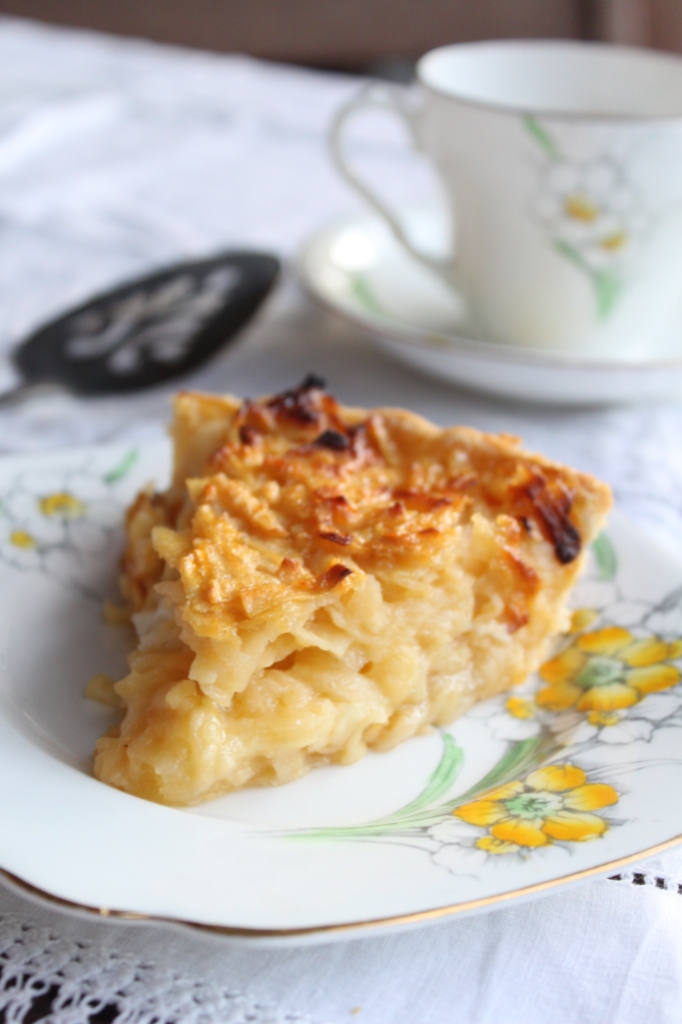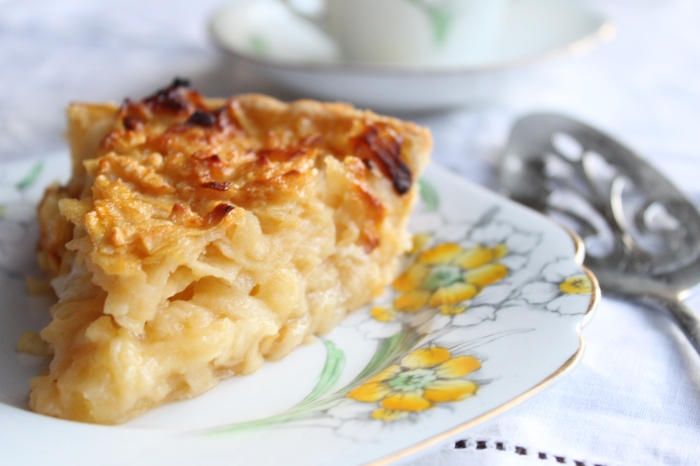The next Historical Food Fortnightly challenge was Today in History which meant making a dish based on, or inspired by, a momentous occasion that took place on that day, and I have to admit I have stretched the limits of the challenge quite a bit. Struggling to find a momentous occasion I turned to Trove (an online database of historical Australian newspapers) and chose a recipe for Marlborough Pie which I found published in The Queenslander on the 2nd July 1881.[1]
Also known as Marlborough Pudding, the pie is actually more of a tart, filled with a creamy lemon and apple mixture and baked until golden. I have to admit that I had never heard of it and I was quite excited about the change of focus (Australian and Victorian rather than English and Early Modern) so imagine my chagrin when I discovered that this dessert had a venerable history stretching all the way back to the 17th century!
The earliest version of the Marlborough Pie that anyone has identified is the recipe for ‘ A Made Dish of Butter and Eggs’ in Robert May’s The Accomplisht Cook[2] which says:
Take the yolks of twenty four eggs, and strain them with cinamon, sugar, and salt; then put melted butter to them, some fine minced pippins, and minced citron, put it on your dish of paste, and put slices of citron round about it, bar it with puff paste, and the bottom also, or short paste in the bottom.[3]
Various other versions were published throughout the 18th century. Hannah Glasse’s The Art of Cookery Made Plain and Easy has a recipe for ‘A Buttered Tort’ which replaces the lemon with Seville orange, and used pulped apple rather than minced[4]. However, it wasn’t until the recipe had crossed to America that the word Marlborough became attached to the custardy apple tart, appearing as ‘Marlborough Pudding’ in the first cookbook published in America, Amelia Simmons’ American Cookery.
Take 12 spoons of stewed apples, 12 of wine, 12 of sugar, 12 of melted butter and 12 of beaten eggs, a little cream, spice to your taste; lay in paste no. 3, in a deep dish; bake one hour and a quarter.[5]
Reading this recipe I was struck by the simplicity of the proportions, 12 spoonfuls of each ingredient. Like a pound cake, it’s an easily memorable recipe which could have been shared between the early American settlers. Although the proportions had changed by the time The Queenslander published their version in 1881, the recipe is still a mere two sentences long. For the 87, 000 women living in Queensland that year[6], many of them on remote stations, the recipes in the paper with their easy to find ingredients and no nonsense instructions (even measuring in tumblers) must have been a source of variety and a connection to the outside world.
The Recipe
Marlborough Pie – Grate six apples, one cup sugar, three tablespoons melted butter, four eggs, juice and grated rind of a lemon. Bake in an under but without top crust.[7]
For the pastry I used another recipe from the same newspaper, Mrs Wicken’s recipe for Short Pastry:
Ingredients: 1 lb flour, 10 oz or 12 oz butter, juice of one lemon, very little water. Mode: Rub the butter very lightly into the flour until quite fine, mix into very dry stiff paste with lemon juice and water. Roll out at once, and it is ready for use.[8]
Although both recipes are rather sparse they worked very well and only a few points were unclear. I wasn’t sure if I should blind bake the pastry before adding the filling, however, as neither the recipe I was following, nor the Hannah Glasse recipe mentioned baking the case prior to adding the apple mix, I chose not to blind bake. Given how wet the filling was, I think that blind baking would probably help keep the crust a bit crisper, but the pie was still delicious without it.
The Redaction
Marlborough Pie
For pastry:
227g flour
170g butter, cut into 1cm cubes
Juice of half a lemon
A little water
For filling:
6 apples, peeled, cored and cut into quarters
1 cup sugar
3 tbsp melted butter
4 eggs
Juice and grated rind of a lemon
1. Preheat the oven to 180˚C and grease a 9” pie dish. In a large bowl rub the butter into flour until it resembles fine breadcrumbs. Add the lemon juice and just enough water to bring the dough together into a ball. Try to avoid over-mixing or kneading the dough.
2. Roll it out onto a lightly floured board and roll out to half a centimetre thick. Carefully lift the dough onto the pie dish and press gently into the base of the dish. Cut off the excess dough and crimp the edge as desired.
3. Grate the apples into a bowl, add the rest of the ingredients and mix well. Pour into the pie dish and smooth the filling with a spoon.
4. Bake for 35 mins or until golden and the filling is no longer liquid. You may need a baking dish below the pie if it is shallow as the liquid may boil over the edge of the dish. Serve hot or cold.
The Recipe: Marlborough Pie (recipe available here) and Mrs. Wicken’s Short Pastry (recipe available here)
The Date: 1881 and 1888 respectively
How did you make it? See above.
Time to complete?: 30 mins prep, 35 mins baking
Total cost: I already had all the ingredients in the house.
How successful was it?: Very tasty, I would definitely make this again. The pastry was buttery and flaky while the apples had just a bit of crunch left. Although the pie was quite sweet, the lemon juice really cut through the sweetness.
How accurate?: The biggest point of inaccuracy is probably the type of apples. I’m not sure which type of apples I used but I think they were Pink Ladies which were only developed in the 1970’s.
Newspaper articles found in Trove reproduced courtesy of the National Library of Australia.
[1] “THE HOUSEKEEPER. Sundry Recipes.,” The Queenslander, July 2, 1881.
[2] Amy Traverso, The Apple Lover’s Cookbook (W. W. Norton & Company, 2011), 201.
[3] Robert May, The Accomplisht Cook, Or, The Art and Mystery of Cookery. (London: printed by R.W. for Nath: Brooke, 1660), 270.
[4] Hannah Glasse, The Art of Cookery, Made Plain and Easy: Which Far Exceeds Any Thing of the … (Printed for W. Strahan, J. and F. Rivington, J. Hinton, 1774), 289, http://archive.org/details/artcookerymadep02glasgoog.
[5] Amelia Simmons, American Cookery (Applewood Books, 1996), 36.
[6] Queensland Treasury and Trade Office of Economic and Statistical Research, “Historical Tables, Demography, 1823 to 2008 (Q150 Release),” accessed July 2, 2014, http://www.qgso.qld.gov.au/products/tables/historical-tables-demography/index.php.
[7] “THE HOUSEKEEPER. Sundry Recipes.”
[8] “PASTRY AND SWEETS.,” Euroa Advertiser, June 22, 1888.
Bibliography
Hannah Glasse. The Art of Cookery, Made Plain and Easy: Which Far Exceeds Any Thing of the … Printed for W. Strahan, J. and F. Rivington, J. Hinton, 1774. http://archive.org/details/artcookerymadep02glasgoog.
May, Robert. The Accomplisht Cook, Or, The Art and Mystery of Cookery. London: printed by R.W. for Nath: Brooke, 1660.
Office of Economic and Statistical Research, Queensland Treasury and Trade. “Historical Tables, Demography, 1823 to 2008 (Q150 Release).” Accessed July 2, 2014. http://www.qgso.qld.gov.au/products/tables/historical-tables-demography/index.php.
“PASTRY AND SWEETS.” Euroa Advertiser. June 22, 1888.
Simmons, Amelia. American Cookery. Applewood Books, 1996.
“THE HOUSEKEEPER. Sundry Recipes.” The Queenslander. July 2, 1881.
Traverso, Amy. The Apple Lover’s Cookbook. W. W. Norton & Company, 2011.



Leanda Connor says:
This is a very tasty dish…Yum!!!
July 2, 2014 — 11:06 pm
Andrea Kuranty says:
Marlborough Pie was delicious! Various elements all working together- melt in your mouth pastry and soft textured apples with a lemon twist. More tastings please!
July 4, 2014 — 12:10 am
Amanda Brown says:
Delicious tart enjoyed at morning tea at CPA!
I have always wondered why you can’t find cooking apples, for example, Bramleys, in Australia. Does anyone know the reason?
However the apples in this tart worked really well.
July 4, 2014 — 12:17 am
qnpoohbear says:
It sounds good. I admire your research. Pippins are a tart apple native to the United States and grown in the fall. If you’re interested in Amelia Simmons, Keith Staveley and Kathleen Fitzgerald have written a history cookbook compiling historical New England recipes. They blog about their culinary experiments, including Marlborough Pudding at http://www.stavelyandfitzgerald.com/blog.htm?tag=Amelia+Simmons
July 14, 2014 — 1:36 am
Kim Connor says:
Thanks, unfortunately Pippins are nearly impossible to get in Australia and, as Amanda said, the same goes for Bramleys and other dedicated cooking apples. After a quick Google search it looks like there are two places in Australia where you can get Bramleys and Pippins as well as other heritage varieties of apples, one is Loriendale Orchard near Canberra and the other is Mt. Alexander Fruit Garden in Victoria. I’m not sure why cooking apples are so hard to find here, but I think that its probably a combination of different growing conditions and a tendency towards varieties which are good for both eating and cooking. In particular we tend to use Granny Smiths for just about everything because of their lovely tartness.
July 14, 2014 — 2:05 am